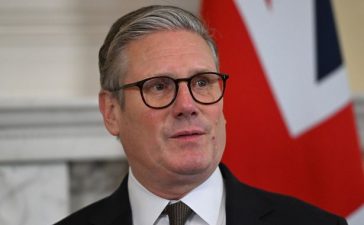If the world continues on its current emissions trajectory, then we have just six more years until these emissions lock in a future where global temperatures rise by 1.5 degrees Celsius, according to updated research released Monday.
In the paper, which offers an updated outlook of the what scientists call our carbon budget — the amount we can emit before we blast through key global warming levels — and slashes in half the predicted amount of time until we lock in 1.5 degrees of warming.
“The window to avoid 1.5 degrees of warming is shrinking, both because we continue to emit and because of our improved understanding of atmospheric systems,” Robin Lamboll, a researcher at Imperial College London and a co-author of the new study, said during a press conference.
Half the time, double the urgency
The study updates an older estimate included in the Intergovernmental Panel on Climate Change’s latest report, which suggested that about 500 billion tons of greenhouse gases could still enter the atmosphere before there is higher than 50% chance of breaching the 1.5-degree threshold for global warming set out by the 2015 Pars Agreement.
The report suggested that we had a little more than a decade until that happened at the current pace of emissions.
The new estimate slashes that time in half. Instead of 500 gigatons, Lamboll and his colleagues suggest that we can emit about 250 gigatons before 1.5 degrees of warming is locked in — that will occur about six years from now at the current emissions pace.
Importantly, that doesn’t mean the world will have crossed the 1.5-degree threshold — though experts do think it is coming by the early 2030s — but rather that we will have emitted enough carbon into the atmosphere to make it all but certain.
“It is clear that high-likelihood options for limiting warming to 1.5 degrees are gone, and they have been gone for a while, to be honest,” said Joeri Rogelj, also of Imperial College London and a senior author of the new study, published in Nature Climate Change.
Recently, the incoming IPCC president has also said 1.5 degrees is more or less a guarantee, when considering the world’s glacial pace in actually trying to cut emissions.
Impacts of other emissions
The new prediction comes in part as a result of scientists’ improved understanding of how aerosol particles affect the climate.
Aerosols are emitted in concert with greenhouse gases but have a cooling effect on the planet — an effect scientists appear to have underestimated. Because there has been a reduction in aerosol emissions from the global shipping industry, which is in the process of changing fuel sources to rein in its own greenhouse gas footprint, it suggests more warming is on the way.
In an accompanying commentary, Benjamin Sanderson of the Centre for International Climate and Environmental Research in Norway wrote that the new study “makes for uncomfortable reading for policymakers.”
He also pointed out that our understanding of aerosols continues to evolve, and that there are still some uncertainties in the findings.
In general, scientists have said that an enormous amount of oil, gas and coal need to remain in the ground, unburned, in order to meet the target.
Some chance is better than no chance
Beyond the shrinking window on the 1.5 degrees target, the new study also re-assessed the carbon budget for keeping warming below 2 degrees Celsius, the fallback target mentioned in the Paris Agreement.
In that case, the news is slightly better: The budget is about 1,200 gigatons, or about 23 years at current emissions levels, to have a 50% chance of keeping warming below 2 degrees.
Rogelj also pointed out some other rays of hope amid the gloom. There are many options still out there that could give a one-in-six chance of limiting warming to 1.5 degrees.
That’s not the sort of probability the world should base its climate plans around, he said, but it does suggest that cutting emissions can have immediate effects.
One in six, Rogelj said, “is most definitely not zero, and it is most definitely not unworthy of pursuit.”








